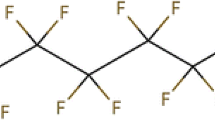Abstract
Recycled paper and board used in food packaging materials (boxes, paper bags) often cause migration of mineral oil into food at levels which are unacceptable according to present toxicological assessments. When foods in recycled board are densely packed into larger boxes or onto pallets, most of the hydrocarbons up to n-C20 may migrate into the packed food within a few weeks, those up to n-C28 at a decreasing rate. Unprinted recycled board contained 300–1,000 mg/kg mineral oil <n-C28. The main sources are the inks used for printing newspapers: newspapers contained roughly 3,000 mg/kg mineral oil <n-C28. These mineral oils fall into classes for which JECFA established a tolerable daily intake of 0.01 mg/kg body weight. Using standard assumptions for calculating specific migration limits, a maximum tolerable concentration in food of 0.6 mg/kg is derived. This evaluation assumes highly refined white oils, whereas the oils found in recycled board are of technical quality and contain 15–25% aromatic compounds, predominantly with 1–3 aromatic rings, as shown by comprehensive GC × GC. This finding precipitates authorities into a dilemma: recycling is supported for the sustainable use of materials, but on the basis of present toxicological assessments the migration is often far beyond acceptable.






Similar content being viewed by others
References
Escabasse JY, Ottenio D (2002) Food Addit Contam 19:79–92
Castle L, Offen CP, Bater MJ, Gilbert J (1997) Food Addit Contam 14:35–44
Sipilainen-Malm T, Latva-Kala K, Tikkanen L, Suihko ML, Skyttä E (1997) Food Addit Contam 14:695–703
Castle L, Damant AP, Honeybone CA, Johns SM, Jickells SM, Sharman M, Gilbert J (1997) Food Addit Contam 14:45–52
Aurela B, Kumala H, Söderhjelm L (1999) Food Addit Contam 16:571–577
Nerin C, Asensio E (2004) Anal Chim Acta 508:185–191
Hagenbarth MJ (2005) Food Addit Contam 22:1042–1052
Bradley EL, Honkalampi-Hämäläinen U, Weber A, Andersson MA, Bertaud F, Castle L, Dahlman O, Hakulinen P, Hoornstra D, Lhuguenot J-C, Mäki-Paakkanen J, Salkinoja-Salonen M, Speck DR, Severin I, Stammati A, Turco L, Zucco F, von Wright A (2008) Food Chem Toxicol 46:2498–2509
Droz C, Grob K (1997) Z Lebensm Unters Forsch 205:239–241
Fauris C, Lundström H, Vilaginès R (1998) Food Addit Contam 15:716–728
Binderup ML, Pedersen GA, Vinggaard AM, Rasmussen ES, Rosenquist H, Cederberg T (2002) Food Addit Contam 19:13–28
Ozaki A, Yamaguchi Y, Fujita T, Kuroda K, Endo K (2005) Food Addit Contam 22:1053–1060
Franz R (2002) Food Addit Contam 19(Suppl):93–110
Baldwin MK, Berry PH, Esdaile DJ, Linnett SL, Martin JG, Peristianis GC, Priston RA, Simpson BJ, Smith JD (1992) Toxicol Pathol 20:426–435
Smith JH, Mallett AK, Priston RA, Brantom PG, Worrell NR, Sexsmith C, Simpson BJ (1996) Toxicol Pathol 24:214–230
Scientific Committee for Food (SCF) (1995) Opinion on mineral and synthetic hydrocarbons, 22 September 1995
Joint FAO/WHO Expert Committee on Food Additives (JECFA) http://www.inchem.org/documents/jecfa/jeceval/jec_1655.htm
Joint FAO/WHO Expert Committee on Food Additives (JECFA) (2002) 59th report. WHO Technical Report Series 913, pp 11–20. http://whqlibdoc.who.int/trs/WHO_TRS_913.pdf
Grob K, Biedermann M, Caramaschi A, Pacciarelli B (1991) J High Resol Chromatogr 14:33–39
Grob K, Lanfranchi M, Egli J, Artho A (1991) J AOAC 74:506–512
Grob K, Artho A, Biedermann M, Caramaschi A, Mikle H (1992) J Assoc Off Anal Chem 75:283–287
Grob K, Artho A, Biedermann M, Mikle H (1993) Z Lebensm Unters Forsch 197:370–374
Grob K, Artho A, Biedermann M (1991) Int Lab 6:12–16
Biedermann M, Fiselier K, Grob K (2009) J Agric Food Chem 57:8711–8721
Biedermann M, Grob K (2009) J Chromatogr A 1216:8652–8658
Biedermann M, Grob K (2009) J Sep Sci 32:3726–3737
Mariani MB, Chiacchierini E, Gesumundo C (1999) Food Addit Contam 16:207–213
Fiselier K, Rutschmann E, McCombie G. Grob K (2009) Eur Food Res Technol 230:619–626
Swiss “Verordnung des EDI über Bedarfsgegenstände”, Article 21, http://www.admin.ch/ch/d/sr/8/817.023.21.de.pdf
Author information
Authors and Affiliations
Corresponding author
Rights and permissions
About this article
Cite this article
Biedermann, M., Grob, K. Is recycled newspaper suitable for food contact materials? Technical grade mineral oils from printing inks. Eur Food Res Technol 230, 785–796 (2010). https://doi.org/10.1007/s00217-010-1223-9
Received:
Revised:
Accepted:
Published:
Issue Date:
DOI: https://doi.org/10.1007/s00217-010-1223-9




